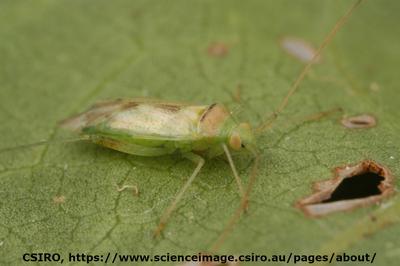Mirid Bugs
Miridae
Insect
In a Nutshell
- Mirid bugs suck sap of terminal buds, flowers and fruits.
- Presence of black spots on the fruits and shrunken and stained seeds on the inside.
- Attacked plants lose strength and show a stunted and branched growth.
Can also be found in
Symptoms
Mirid bugs cause damage on plant terminal buds, flowers and fruits by sucking sap. If attacked before fruit set, plants can loose their terminal bud, leading to stunted and branched growth. Feeding damage on young flowers can cause drying and blasting within 3-4 days. Small and medium-sized flowers are particularly prone to irreversible damage. If flowers develop at all, they often show wrinkled and distorted petals as well as black anthers. Feeding damage on bolls causes black spots on the outside and shrunken and stained seeds on the inside. Yield and quality may be seriously affected in case of severe infestation.
Recommendations

Organic Control
Natural predators can be used to contain the mirid population in an infested field. Damsel bugs, big eyed bugs, assassin bugs, ants and some spider species are known to feed on mirid bugs. Furthermore, treatments with diluted Neem oil and biological insecticides based on the fungus Beauveria bassiana can be used to limit their population. Start to use biological treatment immediately after detection of the pest.

Chemical Control
Always consider an integrated approach with preventive measures together with biological treatments if available. Insecticides containing dimethoate, indoxacarb or fipronil are effective against mirid bugs and can be used to contain severe infestations.
What caused it?
Damage is caused by several species of mirid bugs, depending on the crop. In cotton, the culprits are Campylomma livida, also known as dimple bug (central and northern India) and several members of the Creontiades spp., in particular C. biseratense (southern India). Adults have an oval-shaped, flat body with a greenish-yellow to brown color. A characteristic triangle outlines the center of the back. Eggs are laid individually into leaf petioles and hatch after 4-5 days. Young nymphs can easily be confused with aphids because of size and shape. However, mirid bugs move much faster than aphids. The preferred temperature for C. livida is around 30-32°C. As temperatures deviate from that optimum, their life cycle is slowed down. Particularly hot temperatures above 35°C and heavy rainfalls can decrease the bug population drastically.
Preventive Measures
- Avoid close spacing of cotton plants at planting.
- Plant alternate host plants like lucerne around cotton fields to attract these bugs away from your crops.
- Monitor your plants frequently for signs of infestation.
- Control insecticide use and do not spray broad-range insecticides in order not to affect beneficial insects.
- Remove and burn plant waste and infested plants to avoid further spreading of the pest.



